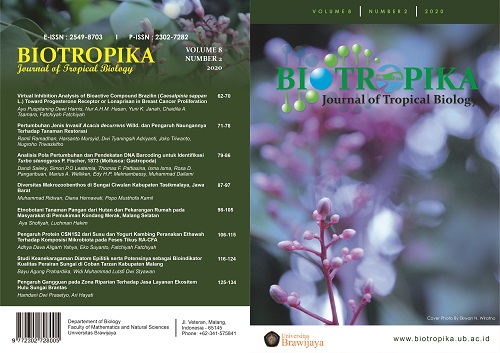Studi Keanekaragaman Diatom Epilitik serta Potensinya sebagai Bioindikator Kualitas Perairan Sungai di Coban Tarzan Kabupaten Malang
DOI:
https://doi.org/10.21776/ub.biotropika.2020.008.02.07Keywords:
bioindikator, coban tarzan, diatom epilitik, sungaiAbstract
Air selalu menjadi kebutuhan penting dalam memenuhi segala aspek kehidupan bagi semua makhluk hidup. Keberadaan sumber daya perairan harus didukung dengan kuantitas yang tercukupi serta kualitas yang baik. Salah satu sumber daya perairan yang sering dimanfaatkan oleh makhluk hidup adalah sungai, terutama aliran sungai yang berasal dari air terjun (coban). Tujuan penelitian ini untuk mengetahui keanekaragaman jenis diatom epilitik serta potensinya sebagai organisme indikator penentu kualitas perairan sungai di Coban Tarzan Kabupaten Malang. Pengambilan sampel diatom epilitik dilakukan dengan metode terpilih (purposive sampling) pada tiga stasiun di perairan sungai Coban Tarzan. Sampel diatom epilitik diambil dari substrat batuan yang terendam air dan tidak lebih dari kedalaman 20 cm. Parameter yang diamati dan diukur antara lain Kepadatan (K), Indeks Keanekaragaman Shannon Wiener (H’), Indeks Dominansi Simpson (C) dan Indeks Tropik Diatom Epilitik. Hasil pengamatan menunjukkan bahwa kepadatan total diatom epilitik yang ditemukan di Coban Tarzan selama penelitian adalah 152.669 ind/cm2, yang terdiri delapan genus (Amphora, Cocconeis, Cymbella, Fragilaria, Gomphonema, Navicula, Nitzschia dan Rhoicosphenia). Sementara itu nilai H’ diatom epilitik di sungai Coban Tarzan menunjukkan tingkat keanekaragaman yang sedang (H’=1,52), sedangkan untuk nilai C menunjukkan tidak ada spesies diatom epilitik yang mendominasi di perairan tersebut (C=0,25). Hasil indeks tropik diatom epilitik menunjukkan perairan sungai Coban Tarzan tergolong memiliki kualitas perairan dengan kategori sedang (mesotrofik).
References
Styawan, Widi, M. L. D. (2019). Studi Keanekaragaman Diatom Epilitik dan Hubungannya dengan Kualitas Perairan di Sub Das Brangkal, Kabupaten Mojokerto, Jawa Timur. Skripsi. UIN Maulana Malik Ibrahim Malang, Jurusan Biologi.
Sensasi Berpetulang di Wisata Alam Baru Air Terjun Tarzan di Malang (2018). https://lifestyle.okezone.com/read/2018/09/09/406/1948032/sensasi-berpetulang-di-wisata-alam-baru-air-terjun-tarzan-di-malang. Diakses tanggal 7 Oktober 2019.
Handayani, S. T, Suhato B. dan Marsoedi. 2001. Penentuan Status Kualitas Perairan Sungai Brantas Hulu dengan Biomonitoring Makrozoobentos: Tinjauan dari Pencemaran Bahan Organik. BIOSAIN. 1(1).
Reavie, R. E. and P. S. John. 1998. Epilithic Diatoms of the St. Lawrence River and their Relationships to Water Quality. Can J Bot. 76: 251-257.
Salomoni, S. E., O. Rocha, G. Hermany and E. Lobo. 2011. Alication of Water Quality Biological Indices Using Epilithic Diatoms as Bioindicators in the Gravatai River Brazil. Brazilian Journal Biology. 71(4): 949-959.
Lobo, E. A., E. W. Carlos, F. Luc, K. Kazuhiro, B. Saul and M. Shigeki. 2010. Response of epilithic diatom communities to environmental gradients in subtropical temperate Brazilian rivers. Limnetica. 29(2): 323-340.
Segura, V. G., A. Enrique, I. Isabel and M. Nora. 2012. Epilithic Diatoms (Bacillariophyceae) as Indicators of Water Quality in the Upper Lerma River Mexico. Hidrobiologica. 22(1): 16-27.
Castilejo, P., C. Susana, P. Luiz, H. Carla, C. Ivonne, G. Z. Jose, C. Juan and L. Eduardo. 2018. Response of epilithic diatom communities to environmental gradients along an Ecuadorian Andean River. Comptes Rendus Biologies.
Paul, S., M. Bipul, M. Manjushre, B. Biswajit, S. Sanoyaz and S. Neera. 2016. Epilithic Diatoms as Biological Water Quality Indcators a Study in Three Geographical Isolated Hill Streams in India. Journal of Enviromental Biology. 37: 275-283.
Hotzel, G. and Roger C. 1999. A Phytoplankton Methods Manual for Australian Freshwaters. Canbera. LWRRDC.
Ayuningsih, M. S, Boedi H dan Pujiono W P. 2014. Distribution and Abundance of Phytoplankton and Chorophyll-a in the Sekumbu Bay Jepara Regency: Relationship with Nitrate and Phosphate Content in Water. Diponegoro Journal of Maquares. 3(2): 138-147.
American Public Health Association. 2005. Standard Methods For the Examination of Water and Wastewater. 17th Edition. New York Health Association. Amer. Publ.
Wardhana, W. 2004. Metoda Prakiraan Dampak & Pengelolaannya pada Komponen Biota Akuatik. Makalah Pelatihan Penyusunan AMDAL. PPSML UI. Jakarta.
Leksono, S. A. 2007. Ekologi pendekatan deskriptif dan kuantitatif. Malang. Bayumedia Publishing.
Fachrul, F. M. 2008. Metode Sampling Bioekologi. Jakarta. Bumi Aksara.
Odum, E. P. 1993. Dasar-Dasar Ekologi. Yogyakarta. Gajah Mada University Press.
Kelly, M. G. and B. A. Whitton. 1995. The Trophic Diatom Index: a new index for monitoring eutrophication in rivers. Journal of Applied Phycology. 7: 433-444.
Kelly, M. G. 1998. Use of The Trophic Diatom Index to Eutrophication in Rivers Monitor. Water Res. 32(1). 236-242.
Srivastava, P., V. Jyoti, G. Sarika and S. Ambrina. 2016. On The Importance of Diatoms as Ecological Indicators in River Ecosystems. Indian Journal of Plant Sciences. 5(1): 70-86.
Pasisingi, N. 2014. Diatom Epilitik sebagai Indikator Kualitas Air di Bagian Hulu Sungai Cileungsi, Bogor. Tesis. Institut Pertanian Bogor.
Soegianto, A. 2010. Ekologi Perairan Tawar. Surabaya. Pusat Penerbitan dan Percetakan (AUP).
Bellinger, E. G. and S.C David. 2010. Freshwater Algae Identification and Use as Bioindicators. Manchester. Willey Blackwell.
Downloads
Published
Issue
Section
License
Copyright and Attribution:
Articles in Biotropika: Journal of Tropical Biology are under Creative Commons Attribution-NonCommercial (CC-BY-NC) copyright. The work has not been published before (except in the form of an abstract or part of a published lecture or thesis) and it is not under consideration for publication elsewhere. When the manuscript is accepted for publication in this journal, the authors agree to the automatic transfer of the copyright to the publisher.
![]() Journal of Biotropika: Journal of Tropical Biology is licensed under a Creative Commons Attribution-NonCommercial 4.0 International (CC BY-NC 4.0).
Journal of Biotropika: Journal of Tropical Biology is licensed under a Creative Commons Attribution-NonCommercial 4.0 International (CC BY-NC 4.0).
Permissions:
Authors wishing to include figures, tables, or text passages that have already been published elsewhere and by other authors are required to obtain permission from the copyright owner(s) for both the print and online format and to include evidence that such permission has been granted when submitting their papers. Any material received without such evidence will be assumed to originate from one of the authors.
Ethical matters:
Experiments with animals or involving human patients must have had prior approval from the appropriate ethics committee. A statement to this effect should be provided within the text at the appropriate place. Experiments involving plants or microorganisms taken from countries other than the author's own must have had the correct authorization for this exportation.

















